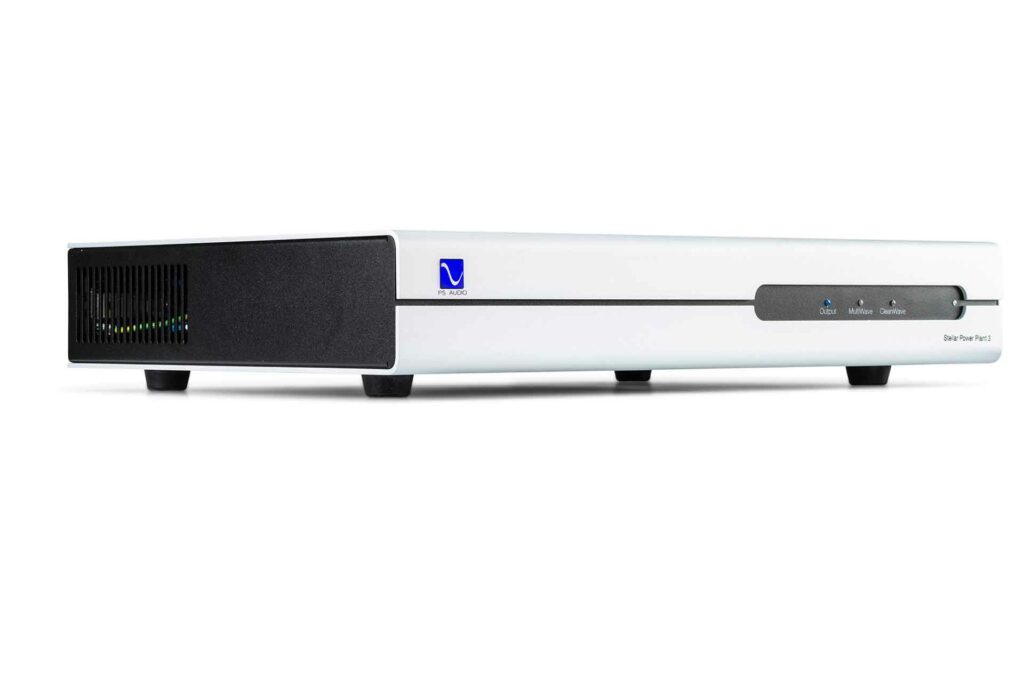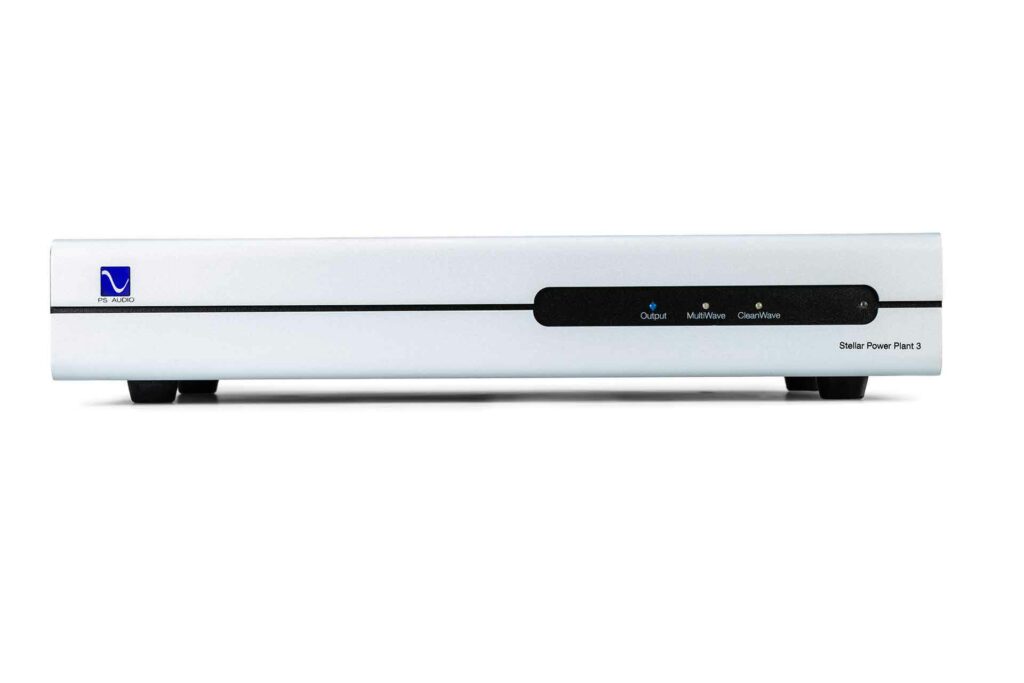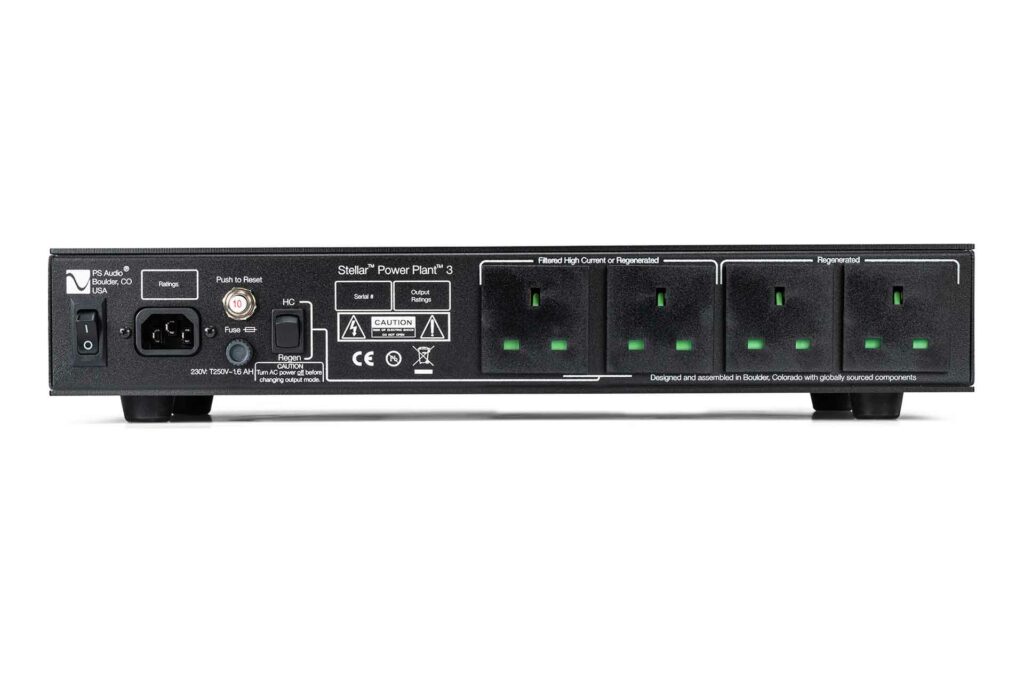The Stellar PowerPlant 3 AC regenerator ($2,999) is PS Audio’s entry-level power regenerator intended for powering audiophile source components as well as small to medium power Class AB amps or high efficiency Class D amps in smaller to medium sized systems. It is important to note that a power regenerator is different from an audiophile power conditioner. A power regenerator takes the incoming AC power from the wall and first converts it to DC, then regenerates and produces ultra-low impedance, sine-wave-perfect, voltage regulated, high-current AC power in order to maximize the performance potential of your system. By providing sinewave-perfect, low-impedance power, PS Audio says it effectively eliminates potential problems commonly found on power lines, such as noise, low or fluctuating voltage, distorted waveforms, and sagging power.
And the farther your home is from the power transformer, the more likely your power will have one or more of these issues. Even if the transformer is as close as mine is (it’s located between my next-door neighbor’s and my house), there’s still a few hundred feet of wire between the transformer and the wall outlets in my listening room. Many other variables play a role, too, such as the gauge of wire running through your walls, how many other neighbors or businesses you share the transformer with, and other loads on the same circuit.

A power conditioner differs from a power regenerator in that it receives the power coming from your wall outlet and acts as a buffer between the outlet and your equipment through the use of filters that are intended to smooth out voltage fluctuations such as spikes, dips, transients, and line noise. Both technologies almost always include surge protection, as well as providing additional outlets for your components. The PS Stellar Audio PowerPlant 3 provides six dedicated outlets with a total continuous power delivery capacity of 300 watts, short-term power (30 seconds) up to 500 watts, and peaks of 900 watts for three seconds. To accommodate high-current components, two of the six outlets can be set to bypass the power regeneration process by flipping the selector switch located on the back. In bypass mode, the incoming power will instead be filtered to those two outlets, similar to a typical power conditioner, enabling delivery of up to 1000 watts of power. Of course, your other choice is to plug a high-current component (typically a power amplifier) directly into a wall outlet.
The design aesthetic of the PowerPlant 3 follows the rest of the Stellar line, with the same sleek chassis of thick, rolled aluminum, for a high-end look. The front panel has a lighted PS Audio logo button that serves to switch the unit between active and idle modes. Putting the unit in idle mode will deactivate all of its output relays. In place of the front panel touchscreens found on the larger PS Audio AC regenerator models are three LED indicators for output, MultiWave, and CleanWave, along with an infrared remote sensor. The output LED changes colors to indicate the percentage of the maximum 300 watts of available power being output to your connected components.
The MultiWave function serves to increase the charge time of the PowerPlant P3’s output waveform to lower the connected equipment’s power supply ripple. This is similar to increasing the power supply capacitance of the connected equipment. The CleanWave function helps to degauss the power supplies and associated cables of the connected electronic components. Slight amounts of DC present on the line of an AC system, as well as constant exposure to magnetic fields, can slightly magnetize the iron and steel components of power supplies. CleanWave can be implemented before beginning a listening session or in between playing CDs, movies, or vinyl with all connected equipment turned on. The CleanWave function runs for five seconds when initiated. These two functions are initiated by pushing the applicable buttons on the included remote control. There is no way to initiate them from the front panel itself, so plan on keeping that remote handy.
On the back panel, there is a power on/off switch, an IEC 120-volt AC power inlet for connecting the included power cord (or a compatible third-party power cord, an option that PS Audio recommends), a reset button and fuse (in case the unit goes into protective fault mode due to too high a current demand or other reason), and the six dedicated outlets mentioned earlier.

What Makes the PS Audio Stellar PowerPlant 3 AC Regenerator Special?
- The Stellar PowerPlant 3 AC regenerator has a high-end fit and finish, with a thick, rolled aluminum chassis providing for a streamlined look. The component feels extremely solid, too, tipping the scales at just under 32 pounds due to its large power supply.
- The Stellar PowerPlant 3 is the least expensive AC regenerator in the PS Audio product line and is capable of ably supplying the power needs of small- to medium-sized systems.
Why Should You Care About the PS Audio Stellar PowerPlant 3 AC Regenerator?
For those with one or more of the common incoming power line issues, such as noise, low or fluctuating voltage, distorted waveforms, or sagging power, the PS Audio Stellar PowerPlant 3 AC regenerator will provide improved power stability to audio equipment, which may result in better audio performance depending on the type of power supply used in your components.There are many factors that can negatively impact the quality and stability of the power sent to your audio gear, so the improvements realized by adding an AC regenerator can vary depending on each person’s unique situation.
The PS Audio Stellar PowerPlant 3 AC regenerator might just be the perfect clean power solution for small- to medium-sized audio systems. The 300 watts continuous and 900 watts peak sinewave power delivery, fully regulated output voltage, ultra-low impedance, and MultiWave function combine to provide pure power with rock-solid stability to the owner’s audio equipment.
Some Things You Might Not Like About the Stellar PowerPlant 3 AC Regenerator
- The use of LED indicators rather than the touchscreen featured on the larger PS Audio DirectStream PowerPlant models is less convenient. The LEDs provide less information visually, such as the measured incoming and outgoing Total Harmonic Distortion (THD),incoming and outgoing voltage, and a visual graphic of the incoming and outgoing sinewave, all of which are accessible from the touchscreen found on the larger PS Audio models. And unlike its pricier siblings, the Stellar PowerPlant 3 cannot be connected to the internet to view historical data on the PS Audio website. In addition, with no touchscreen, the PS Audio Stellar PowerPlant 3 requires use of the included remote control to activate the MultiWave and CleanWave functions. However, in order to reach the price point of the PS Audio Stellar PowerPlant 3, I suppose some functionality had to give way.
- The Stellar PowerPlant 3 is a bit limited in terms of power demand and system complexity it can support with its 300-watt maximum continuous output capacity and six power outlets. Those with Class A or larger Class AB amplifiers will need to plug their amps directly into the wall outlet, or choose to switch the two optional high-current outlets to the “filter high current” mode and thereby forego the benefits of power regeneration. And those with more sources than the outlets will accommodate will need to prioritize which sources to plug into the Stellar PowerPlant 3 versus directly into a wall outlet. Alternatively, another option would be to move up to one of the larger, more expensive PS Audio DirectStream PowerPlant AC regenerators.
Listening to the PS Audio Stellar PowerPlant 3 AC Regenerator…
For my evaluation of the Stellar PowerPlant 3, I connected the AC regenerator to the wall outlet using a WireWorld power cable instead of the provided stock cable. I also connected the PS Audio Stellar S300 stereo amplifier and source components to the PS Audio Stellar PowerPlant 3 AC regenerator using WireWorld power cables.
These are the same power cables I’ve used for sources plugged into PS Audio’s previous generation PerfectWave PowerPlant 5 AC regenerator, which has been a staple in my system for several years. I purchased the PerfectWave PowerPlant 5 because I was bothered by the low-level background noise that was evident in my system. The touchscreen of the PerfectWave PowerPlant 5 can display some key power attributes, as mentioned above. By monitoring the display of the PerfectWave PowerPlant 5 over a period of time, I discovered that the THD of the power coming from my wall ranges from 5.0 to 7.0 percent, while the THD of the power being output from the PerfectWave PowerPlant 5 is typically 0.3 to 0.5 percent. The incoming voltage varies from 116 to 124 volts, while outgoing voltage from the PerfectWave PowerPlant 5 is much more consistent, ranging from 119.8 to 120.2 volts. I could also see the distortion of the sinewave of the incoming power versus the perfect sinewave of the power output from the PerfectWave PowerPlant 5. Adding the PerfectWave PowerPlant 5 to my system immediately eliminated the background noise issue I had been experiencing.
I set up two comparative listening tests for this evaluation. First, I compared the same tracks both with and without the new Stellar PowerPlant 3 in my system. Second, I compared the PowerPlant 3 to my previous-generation PerfectWave PowerPlant 5 by swapping component power connections back and forth between the two and listening to the same tracks. I should mention that while the PerfectWave PowerPlant 5 was the entry-level AC regenerator in PS Audio’s lineup at the time I purchased it, its current successor is really the PS Audio PerfectWave PowerPlant 12 ($5,999), which is one step up from the PS Audio Stellar PowerPlant 3 under review here. So, while technically not an apples-to-apples comparison, I thought it would be interesting to see what sonic differences I could identify, if any, between the two regenerators.
For both comparisons, I used the PS Audio Stellar S300 stereo amplifier that I recently reviewed. The amplifier had been in my system for almost three months at this point, so I was very familiar with its sound. I had no concerns that the PowerPlant 3 AC regenerator could meet the power demands of the amp, since they were designed by PS Audio to be complementary components.
Throughout the first evaluation, the difference in audio performance between having the Stellar PowerPlant 3 in and out of my system was immediately and consistently apparent. And the difference was obvious, not subtle. Powered by the PS Audio Stellar PowerPlant 3, I consistently experienced an improvement in noise floor, bass dynamics, and details of individual instruments. Both instrument and vocal note sustains and decay were more realistic, bringing a greater sense of musicality to each track. Listening to the Minnesota Orchestra perform Aaron Copland’s “Fanfare for the Common Man” (Reference Recordings CD, 16-bit / 44.1 kHz), the kettle drums and had greater impact, the various horn instruments were portrayed with a better-defined sense of their individual character, sounding closer to live music than a recording. The quiet moments that are interspersed between the dramatic, impactful moments of the piece were even quieter via the PS Audio Stellar PowerPlant 3. The instruments were also better defined within the soundstage, which appeared to be slightly larger when power was supplied from the AC regenerator.
Listening to Cian Ducrot’s “All for You” (Qobuz, 24-bit / 48 kHz), I could hear more detail in the grittiness in this Irish singer’s vocal, along with more reverberant decay in the piano notes, giving a greater sense of the intimate recording space. The piano appeared to have a bit more bass weight on low notes too. There was a lower noise floor through the AC regenerator, allowing me to hear every breath that Cian took, even in the quieter, somber moments. The additional details resulted in greater musicality and emotional impact. And isn’t that why we’re in this hobby after all – to be moved emotionally by the music?
For the second part of my evaluation, I switched between my older PerfectWave PowerPlant 5 and the newer Stellar PowerPlant 3. While having less power output capacity, the Stellar PowerPlant 3 is reported to have one-third the impedance of the previous PerfectWave PowerPlant 5 model. I wondered whether that would result in a sonic difference. I listened to the same tracks repeatedly, switching power cabling between the two AC regenerators between plays. Try as I might, I could not detect a definite audible difference between the two models. It could be that there is a subtle difference that I couldn’t detect due to the time it took to switch connections between AC regenerators. Perhaps if there was a way to instantly switch between the two regenerators, I would have heard some subtle differences. While I couldn’t hear any improvement in performance, I couldn’t detect any drop in performance either. I think that’s actually a plus for the Stellar PowerPlant 3. After all, it has less power output capacity (300 watts continuous versus 1000 watts continuous) and is less expensive, yet still seemed its equal in terms of performance.
Does the PS Audio Stellar PowerPlant 3 AC Regenerator Have Any Resale Value?
My experience with PS Audio products in general is that they are well made and usually provide many years of dependable use. The value-priced Stellar PowerPlant 3 is without a peer with the same technology at its price point, so for those starting off with the PowerPlant 3 and wanting upgrade to a larger model in a few years, there should be a reasonable return available in the used market. In addition, PS Audio offers a trade-in program when upgrading to a more expensive component, so that may be a good option down the road for those wanting to upgrade from the PowerPlant 3.

Who Is the Competition for the PS Audio Stellar PowerPlant 3 AC Regenerator?
In the case of power regenerators, that’s a tough question. I’m not aware of a competitor to the Stellar PowerPlant 3 in the same general price range. I suppose the real competitor to the PowerPlant 3 is actually a power conditioner. Three of the most well-known and respected companies making power conditioners at a similar price point are Shunyata Research, Audioquest, and IsoTek.
Shunyata Research makes the Hydra Delta D6 power conditioner ($3,500), which has three zones of isolation (two outlets each) for a total of six outlets and a maximum total outlet current of 20 amperes. Audioquest offers the Niagara 3000 ($3,900), a model with two high-current outlets and five medium-current outlets, rated at 15 amperes maximum output. Finally, the IsoTek V5 Aquarius power conditioner ($2,995) features two high-current outlets and four medium-current outlets. So really, for those seeking to rectify power issues, the choice comes down to either power regeneration from PS Audio, or power conditioning from one of many competitors.
Final Thoughts on the PS Audio Stellar PowerPlant 3 Power Regenerator
The Stellar PowerPlant 3 is a well-built piece of high-end gear that provides a solid, stable power foundation for enthusiasts experiencing variable incoming power from their wall. In my room, with my equipment and less than perfect power coming from the wall, I experienced a substantial performance boost from having the PS Audio Stellar PowerPlant 3 AC regenerator in my system. I would equate it to upgrading one or maybe even two components in an audio system. Each individual’s actual experience will depend on their unique circumstances regarding those same variables. Given that PS Audio offers a free in-home trial, those experiencing variable power quality from their wall outlets have nothing to lose by trying out the PS Audio Stellar PowerPlant 3 in their own systems.



